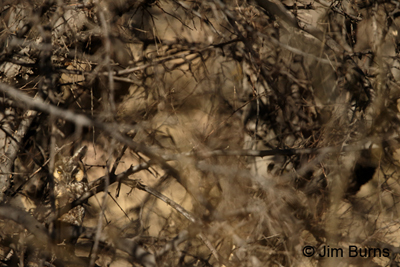
Sunrise creeps over the Santa Ritas. The desert hackberry grove, dense and dark moments before, is flooded now with direct sunlight. The splashes of whitewash, fifty yards off trail and low along the vines and tangled trunks, leap to the eye, inviting closer binocular investigation. The owls are there . . . somewhere. As I mentioned in my preceding column, species with camouflage coloration makes even finding them a treasure hunt.
It takes nearly five minutes of intense, eye watering scrutiny. Finally the first outline takes shape, the dark, vertical belly barring blending maddeningly into the twigs, loose bark, and forest detritus. Then a second, lower and to the left, perhaps five feet from the first, its discovery enhanced by the buffy facial disk rendered bright and nearly orange in the morning’s intensifying light. There may be more—Long-eareds on a communal winter day roost. Props to whomever first discovered this group.
Long-eared Owls are typically designated “uncommon” throughout the literature in their range across the northern two-thirds of the country, and they seem particularly so in the desert Southwest. Though they are listed as breeders here and there is one photo of an active nest, I’ve never spoken to anyone who has seen a nest in Arizona. If I were looking in breeding season, I’d look north of the rim in Pinyon/Juniper adjacent to open scrub/steppe. In short, Long-eareds are nomadic breeders in Arizona, following periodic and local abundance of small rodent prey such as kangaroo rats and meadow voles.
Long-eareds share the distinction, with Short-eareds, of being the only North American owls that roost colonially in non-breeding season though the latter, of course, are grassland birds. This little colony in the hackberries, perhaps numbering up to half a dozen birds, is ensconced in the densest section of the vegetation, each individually tight against the trunk of a tree. Though the long ear tufts are visible, the two birds I can see appear at ease, dozing, eyes occasionally opening if a raven calls or a branch falls.
Long-eareds, when disturbed, adopt the most remarkable concealment posture of all our owls: the “ears” go straight up, the body is elongated, and one folded wing is brought forward to cover the ventral body markings, making the owl virtually impossible to distinguish from surrounding vertical, bark covered branches. Did I mention props to whomever first discovered this group.
With this sighting, I can still count the number of times I’ve seen Long-eared Owls in Arizona, in nearly forty years, on one hand, all between mid-December and late February on day roosts. I need only two hands to count my total Long-eared sightings in North America. These birds will probably be here until mid-March, then disperse to nest, perhaps not traveling too far as there are ample open areas, desert washes, and agricultural fields nearby. Only an abundance of prey is needed to attract and hold this habitat generalist.